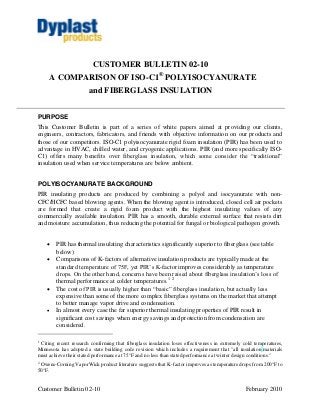
Customer Bulletin 0210 A Comparison of ISO-C1 Polyiscocyanurate and Figerglass Insulation
- 1. CUSTOMER BULLETIN 02-10 A COMPARISON OF ISO-C1® POLYISOCYANURATE and FIBERGLASS INSULATION PURPOSE This Customer Bulletin is part of a series of white papers aimed at providing our clients, engineers, contractors, fabricators, and friends with objective information on our products and those of our competitors. ISO-C1 polyisocyanurate rigid foam insulation (PIR) has been used to advantage in HVAC, chilled water, and cryogenic applications. PIR (and more specifically ISO- C1) offers many benefits over fiberglass insulation, which some consider the “traditional” insulation used when service temperatures are below ambient. POLYISOCYANURATE BACKGROUND PIR insulating products are produced by combining a polyol and isocyanurate with non- CFC/HCFC based blowing agents. When the blowing agent is introduced, closed cell air pockets are formed that create a rigid foam product with the highest insulating values of any commercially available insulation. PIR has a smooth, durable external surface that resists dirt and moisture accumulation, thus reducing the potential for fungal or biological pathogen growth. PIR has thermal insulating characteristics significantly superior to fiberglass (see table below) Comparisons of K-factors of alternative insulation products are typically made at the standard temperature of 75F, yet PIR’s K-factor improves considerably as temperature drops. On the other hand, concerns have been raised about fiberglass insulation’s loss of thermal performance at colder temperatures.1 2 The cost of PIR is usually higher than “basic” fiberglass insulation, but actually less expensive than some of the more complex fiberglass systems on the market that attempt to better manage vapor drive and condensation. In almost every case the far superior thermal insulating properties of PIR result in significant cost savings when energy savings and protection from condensation are considered. 1 Citing recent research confirming that fiberglass insulation loses effectiveness in extremely cold temperatures, Minnesota has adopted a state building code revision which includes a requirement that "all insulation materials must achieve their stated performance at 75°F and no less than stated performance at winter design conditions." 2 Owens-Corning VaporWick product literature suggests that K-factor improves as temperature drops from 200°F to 50°F. Customer Bulletin 02-10 February 2010
- 2. PIR’s compressive strength is much higher than fiberglass, resisting mechanical abuse (personnel stepping on insulation) and maintaining its integrity. Availability of higher density PIR (e.g. 6 lb/ft3) means even higher compressive strengths can be achieved for use in saddles in clevis-type pipe hangars, thereby eliminating metal penetrations through the insulating system. Because the surface is tough and resilient, it has a higher degree of puncture resistance when compared to fiberglass products. Even if the insulation surface is punctured, torn or otherwise damaged, the product still resists moisture absorption and microbial growth. PIR’s water absorption and water vapor transmission properties are very superior to those of fiberglass. PIR does not require an outer moisture vapor barrier or liner because the closed cell structure will not absorb moisture (absorbs significantly less moisture than fiberglass). Addition of a vapor retarder, however, may be cost effective (particular when system temperatures are below freezing) by providing additional assurance against condensation and also will improve appearance. The surface is more readily cleaned (compared to fiberglass) if necessary to further resist microbial growth. PIR resists compression due to its rigidity and hence retains its thermal insulating capacity to a greater degree than fiberglass will under compressive forces. Code and Test Standard Conformance Indoor installations of piping insulation (e.g. chill water systems) often fall under the International Mechanical Code requirements for Building Products for Air Plenums. This code requires that certain flame spread and smoke development be met, namely 25/50 respectively as tested per the ASTM E84 standard, unless there are other mitigating protection such as sprinkler systems. Since sprinkler systems are typically required by other building code requirements the 25/130 Factory Mutual rating of ISO-C1/2.0 makes it an acceptable alternative to fiberglass. Dyplast’s Phenolic foam insulation is an additional alternative when sprinklers are not available. Conclusion The use of PIR closed cell foam Insulation in HVAC, chilled water, and cryogenic applications is the preferable alternative to fiberglass insulation. PIR offers several advantages over fiberglass with regard to moisture absorption and its resistance against microbiological contamination. It is a superior product in its durability when compared to fiberglass. PIR may cost more than fiberglass, but when one reviews the benefits of PIR - - primarily K- factor - - and other properties such as inhibition of microbial growth, an objective cost vs. benefit analysis overwhelmingly swings the decision in favor of PIR. Customer Bulletin 02-10 February 2010
- 3. Insulation K-factor R-value per inches Tempera- Density Moisture Vapor @ 75F specified ture Absorption Transmission Range lb/ft3 1 2 3 4 ISO-C1 0.18 5.6 11.1 16.7 22.2 -297 to 2 to 10 0.24 2.33 (PIR) +300 Fiberglass 0.22-0.30 3.8 7.7 11.5 15.4 -80 to 2 to 9 ?4 ?5 (pipe) +1000*3 3 Certain fiberglass insulation with liners has restricted operating temperatures. VaporWick, for example, is designed for systems between 32 and 220F. At temperatures below freezing, special attention must be paid to vapor retarder protection. 4 Water absorption in fiberglass is measured by different ASTM standards than PIR. Although water absorption in fiberglass pipe insulation has traditionally been expressed as a concern, some manufacturers claim a Water Sorption of <1% as measured by ASTM C1104. Yet other authorities state that “Just 4% moisture can lower thermal efficiency by up to 70%.” 5 Water vapor transmission for fiberglass insulation is normally not quoted unless a liner (skin) is involved, and then only the WVT of the barrier is typically quoted. Customer Bulletin 02-10 February 2010